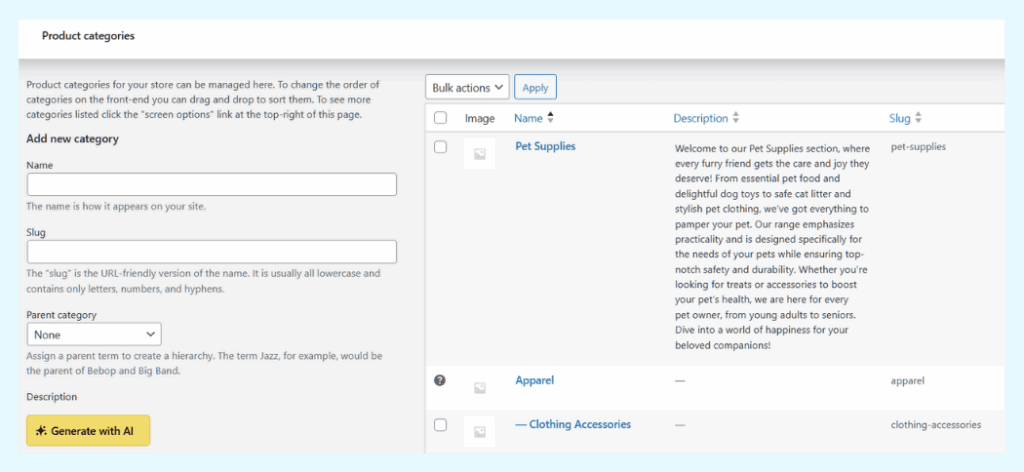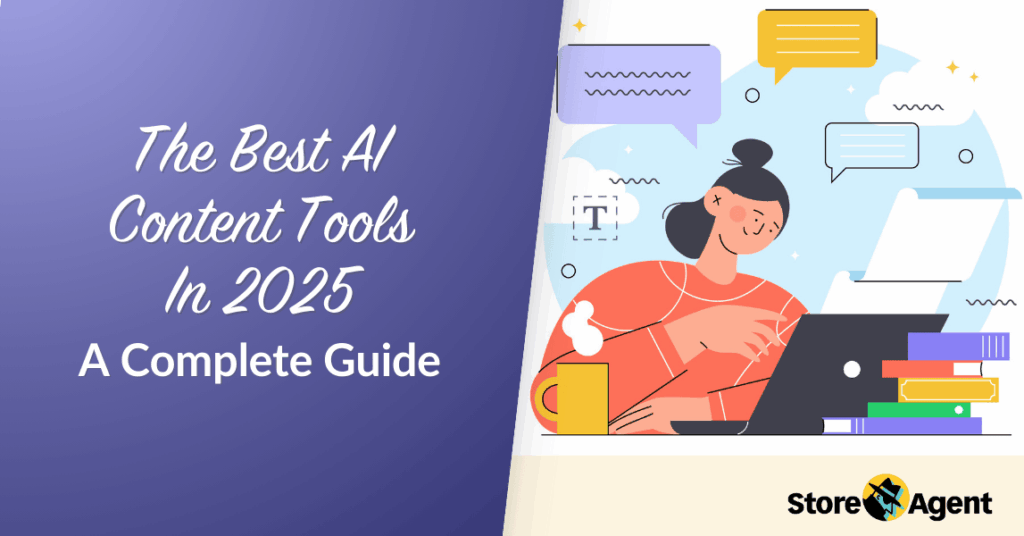
AI content tools save time and help you create clear, engaging content. They are essential for businesses that need to produce lots of high-quality copy quickly. Using the right tools can improve your content’s reach and effectiveness without adding extra work.
This guide highlights the best AI content tools for 2025. You will discover which tools fit different needs, from blogs and social media to WooCommerce stores. This makes it easier to choose the tool that works best for your workflow and goals.
Table of Contents
- Table of Contents
- What Are AI Content Tools?
- What's Your Goal? Find The Right AI Content Tools For The Job.
- Best For General & Long-Form Content
- Best AI SEO & Optimization Tools
- Best For Social Media & Short-Form Copy
- Top-rated AI Content Tool For Online Stores & Ecommerce
- Conclusion
- Frequently Asked Questions
- Will AI-generated content sound generic or like a robot?
- Is AI-generated content unique? Will I get penalized for duplicate content?
- Are AI content tools worth the monthly cost for a small store?
- How do I choose between the top-rated AI content tools for online stores?
- Does using AI mean I don't need a human writer anymore?
What Are AI Content Tools?
AI content tools are software applications that use artificial intelligence, particularly large language models (LLMs), to help users plan, draft, optimize, and repurpose content.
This includes not only text-based content like articles and product descriptions but also extends to creating images, audio, and video, making them a comprehensive solution for modern marketing and content creation workflows.
What’s Your Goal? Find The Right AI Content Tools For The Job.
To find the right tool, first consider your main goal. Different roles require very different features.
For example, a Blogger or Content Marketer needs a tool that excels at long-form, creative content. In contrast, a Social Media Manager needs a platform built for short, punchy, and engaging copy.
Finally, an E-commerce Store Owner, especially one using WooCommerce, has unique needs. They require a specialist tool that understands products, SEO, and store data.
📝 Note: I tested these tools from a store owner’s chair: Woo sync, bulk generation, category support, review mining, time-to-first-draft, edit effort, and maintainability. I prioritized workflow fit over model hype and re-run key flows regularly. Last reviewed September 2025.
With those different goals in mind, the table below provides a quick overview of the top AI content tools we tested. Use it to easily compare their strengths and see which platform is the best fit for your specific role.
| AI Content Tool | Best For | Key Features | WooCommerce Integration | Pricing |
|---|---|---|---|---|
| Jasper | General & Long-Form Content | Brand Voice, Team Collaboration | No | Starts at $49/mo |
| ChatGPT | Flexible Writing & Research | Versatile Prompts, Creative Output | No (Requires custom API development) | Free tier; Plus $20/mo |
| SurferSEO | SEO Content Optimization | Data-Driven Briefs, Content Scoring | No | Starts at $79/mo |
| SEMrush Content Toolkit | SEO & Content Planning | Keyword Research, Topic Discovery | No | From $139.95/mo |
| Copy.ai | Social Media & Short-Form Copy | Multi-Model Access, AI Agents | No | Free tier; Pro $249/mo |
| StoreAgent for WooCommerce | Ecommerce Content Automation & Multilingual Content | Woo Sync, Bulk Generation, Insights | Yes (Native Plugin) | Free plan; Pro $49/mo |
💡 Must Know: For SKU-heavy WooCommerce stores, platform sync + bulk and category support matter more than raw model power. That’s where StoreAgent outperforms generalists.
Best For General & Long-Form Content
These platforms are the powerhouses of content creation. They excel at drafting blog posts, articles, scripts, and any other long-form content, turning a blank page into a near-finished product in minutes.
Jasper
Jasper has grown far beyond a simple AI writing assistant. Today, it stands as a comprehensive AI marketing platform known for its powerful editor and a wide array of advanced features for professional teams.

It’s known for its robust editor and advanced Brand Voice features that learn your company’s tone, style, and product catalog.
How I Tested
To test Jasper, I used it to build out a complete marketing campaign. I created everything from the initial blog post to the social media ad copy.
This approach allowed me to evaluate its “Brand Voice” feature across different content types. It also gave me a chance to see how the collaborative “Canvas” functions in a team setting.
Why I Recommend It
I recommend Jasper for marketing teams who need a single platform for campaign creation. Its features are built to keep brand messaging consistent across all assets.
Although it isn’t designed for managing individual WooCommerce products, it is a powerful tool for marketing professionals. It excels at centralizing the entire content creation workflow, from planning to final copy.
- Pros: Excellent for team collaboration with a shared content canvas. Its vast library of templates is still one of the best available.
- Cons: No direct integration with e-commerce platforms like WooCommerce, making it inefficient for managing product descriptions at scale.
- Pricing: Starts at $49/month.
ChatGPT
ChatGPT is the world’s most popular conversational AI for a reason. Its flexibility is its greatest strength. It can brainstorm ideas, conduct research, write in any style, and tackle virtually any text-based task you give it.
How I Tested
I tested ChatGPT by giving it the same task as the other general-purpose tools: creating a product description. To get a high-quality result, I had to write a very detailed prompt that included the target audience, tone of voice, key features, and SEO keywords.
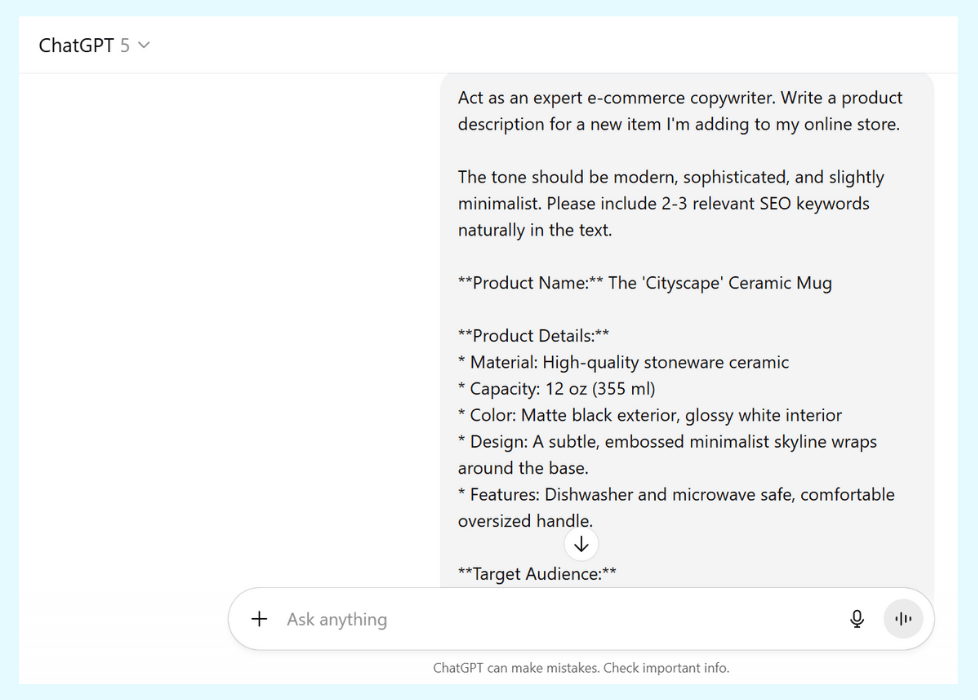
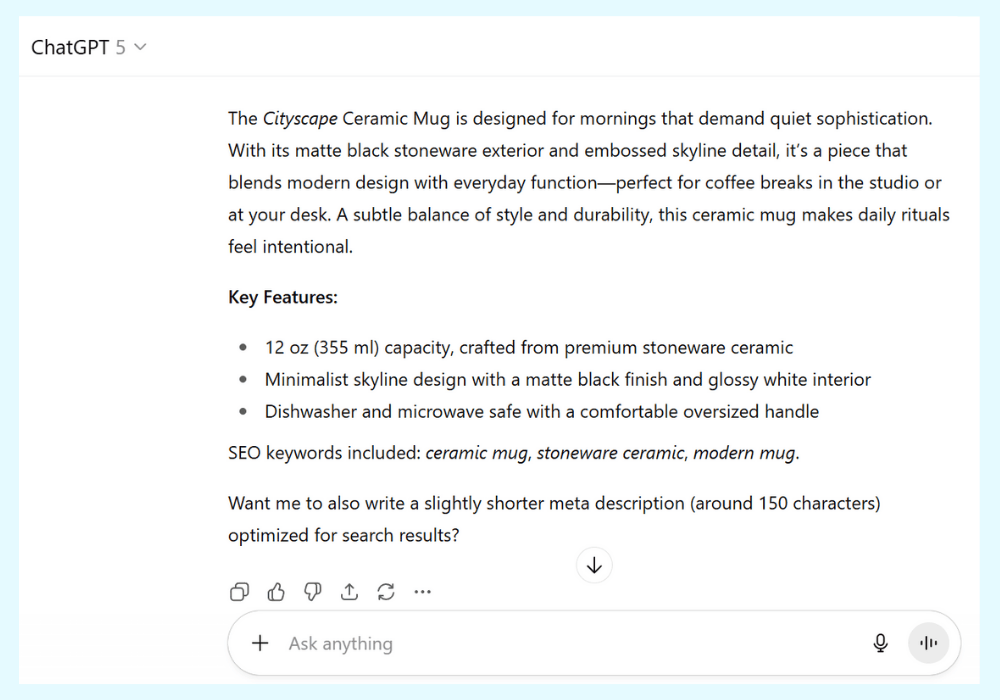
Why I Recommend It
I recommend ChatGPT for users who are comfortable with a hands-on approach and need a tool for a wide variety of tasks. Its power lies in its versatility, but it requires you to provide all the context and structure for each request.
While it’s not an efficient tool for managing an entire e-commerce catalog, it is an excellent assistant for one-off tasks. It’s perfect for brainstorming marketing angles, drafting a single blog post, or getting a quick answer to a complex question.
- Pros: Extremely versatile and powerful. The latest models have excellent reasoning and creative capabilities.
- Cons: It’s a “blank canvas” that requires detailed, specific prompts to get high-quality, structured results. It lacks a built-in workflow for specialized tasks.
- Pricing: Free tier available; Plus plans start at $20/month.
Best AI SEO & Optimization Tools
Creating content is only half the battle. These tools use AI to analyze top-ranking pages and provide data-driven recommendations to help your content rank higher on search engines like Google.
SurferSEO
SurferSEO is a market leader in content optimization. It analyzes search results for your target keyword and builds a dynamic brief that tells you exactly what headings, keywords, and topics to include for the best chance of ranking.
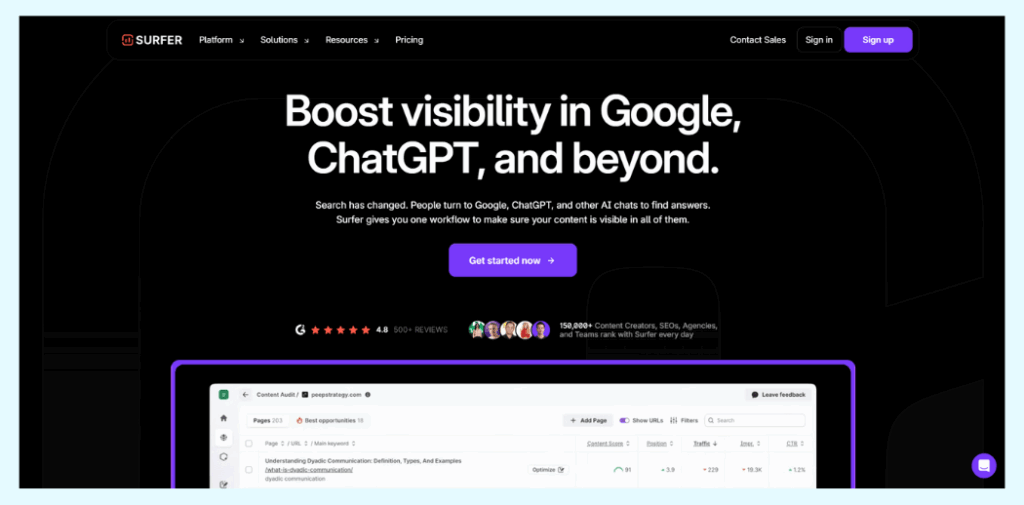
How I Tested
I tested Surfer by taking an existing blog post and using the “Content Editor” to optimize it. My focus was on its core feature: the real-time “Content Score.”
Following its data-driven recommendations, the article’s score went from a 52 to an 88 in about 30 minutes. This demonstrated how quickly a writer can improve an article’s on-page SEO by following a clear, guided process.
Why I Recommend It
I recommend Surfer for any content or SEO writer who wants to create top-ranking articles efficiently. Its real strength is making complex on-page SEO simple with an actionable score.
While its keyword research tools are not a replacement for a dedicated SEO platform, it is exceptional at its main job. It provides a straightforward, data-driven path to optimizing content that anyone can follow.
- Pros: Provides a clear, actionable score to guide your writing. Its Content Editor makes optimization straightforward.
- Cons: The keyword research and audit tools are less robust than dedicated SEO platforms like Ahrefs or SEMrush.
- Pricing: Starts at $79/month.
SEMrush Content Toolkit
Part of the massive SEMrush SEO suite, Content Toolkit is an app designed to help you generate ideas, write, and optimize content quickly. It leverages SEMrush’s powerful keyword and competitor data to inform its suggestions.
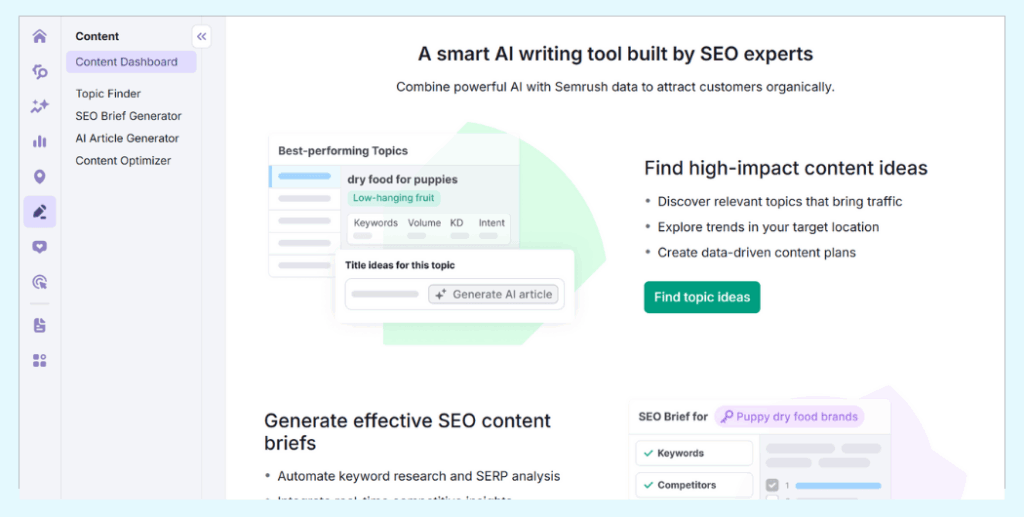
How I Tested
To test the toolkit, I used its “Topic Research” feature to identify a low-competition keyword for a new blog post. I then used the “SEO Content Template” to generate a data-driven brief based on top-ranking competitor articles.
Finally, I wrote an article using the “SEO Writing Assistant,” which provided real-time feedback on readability, keyword usage, and tone of voice.
Why I Recommend It
I recommend the SEMrush Content Toolkit for marketers and businesses that are already invested in the SEMrush ecosystem. Its true power comes from the seamless integration with the platform’s industry-leading keyword and competitor data.
While it can be overwhelming for beginners, it is an incredibly powerful solution for serious content teams. It helps you move from research to writing to optimization all within a single, unified workflow.
- Pros: Seamlessly integrated with SEMrush’s industry-leading SEO toolkit. Helps you find content ideas with low competition.
- Cons: Can be overwhelming for beginners, and the full value is unlocked only if you use the broader SEMrush platform.
- Pricing: Included with SEMrush plans, which start at $139.95/month.
Best For Social Media & Short-Form Copy
Next, let’s look at platforms that specialize in creating snappy, attention-grabbing copy. They specialize in creating short, punchy copy for social media posts, ads, and emails, and can cleverly repurpose long-form content into bite-sized assets.
Copy.ai
Copy.ai has evolved into a powerful and versatile marketing hub. Its standout feature is that it brings multiple leading AI models, like GPT and Claude, into a single, centralized workspace for your team.
Its standout feature is the Content Agent Studio, which provides specialized AI agents for common marketing tasks like writing email campaigns or generating Instagram captions.
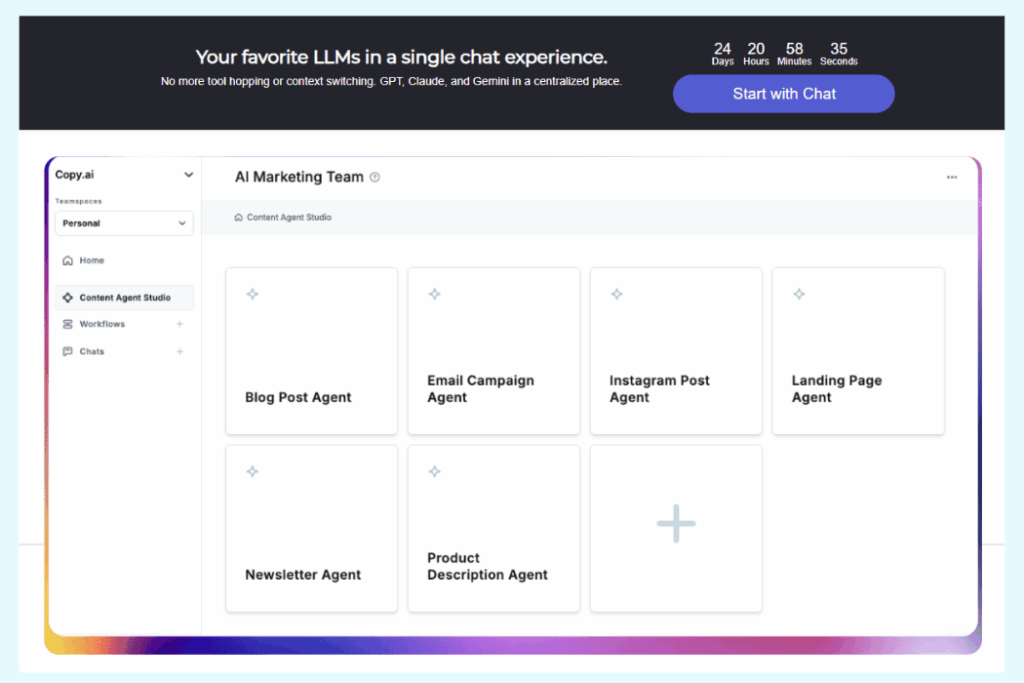
How I Tested
I tested Copy.ai by using its “Content Agent Studio” to create a series of marketing assets. This included drafting an email campaign and generating several social media posts. The test focused on how well the specialized agents handled these distinct marketing tasks.
Why I Recommend It
I recommend Copy.ai for marketing teams that need to produce a high volume of diverse content. Its agent-based workflow is intuitive and simplifies launching targeted campaigns for ads, email, and social media.
- Pros: Multi-model access lets you choose the best AI for the job. Its agent-based workflow is intuitive for marketers.
- Cons: Like other general tools, its e-commerce features are not directly synced with store data, requiring manual copy-pasting for product copy.
- Pricing: Free tier available; Pro plans start at $249/month.
Top-rated AI Content Tool For Online Stores & Ecommerce
Now, let’s talk about e-commerce. This is a question I see all the time: “Why can’t I just use ChatGPT or Jasper for my store?”
The honest answer is, you absolutely can.
These general AI content tools are fine for writing a one-off product description or brainstorming a marketing angle.
But the moment you need to handle more than a handful of products, the manual work becomes overwhelming. The real challenge for any online store isn’t writing one description; it’s efficiently managing content for your entire catalog.
This is where a specialist tool becomes necessary. It’s not just about writing the content anymore. You have to think about integration, scale, and workflow.
A dedicated e-commerce tool is built to handle the data and volume that general AI content tools simply aren’t designed for.
StoreAgent for WooCommerce
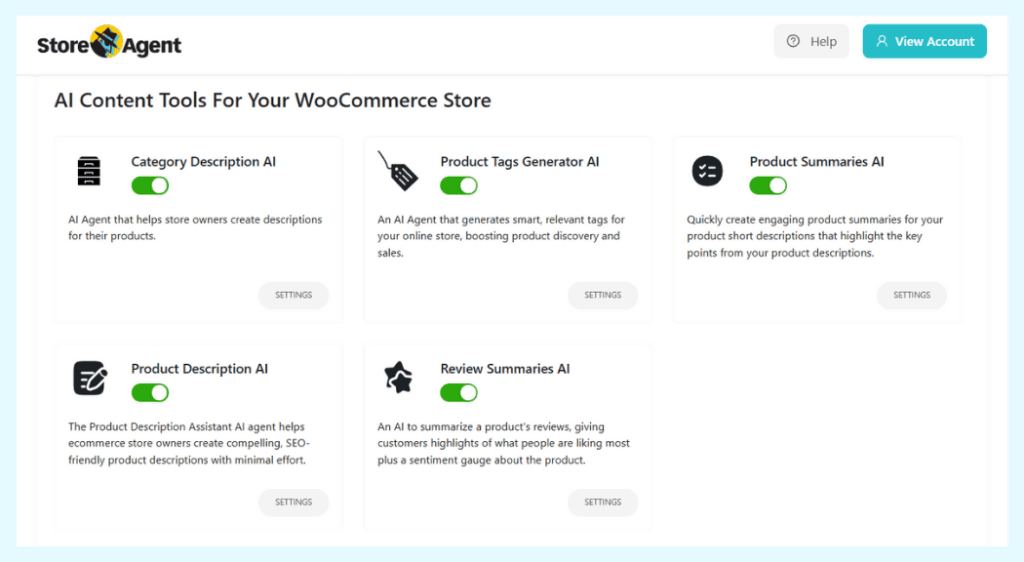
StoreAgent is a suite of AI tools built to function as a co-pilot directly inside of WooCommerce. It turns your existing product data (titles, attributes, images) into SEO-ready product and category copy that is synced directly to your store.
Its key advantages for store owners are:
- Bulk Generation: Create or refresh descriptions for hundreds of SKUs in a single workflow, saving dozens of hours.
- Multilingual Content Generation: Its powerful multilingual AI allows you to instantly create high-quality multilingual content, including product descriptions, tags, and summaries in dozens of languages to reach a global audience.
- Full Page Optimization: It goes beyond descriptions to auto-generate product tags, short summaries, and SEO-optimized category page content.
- Insight Engine: Its dashboard proactively finds and helps you fix thin or missing content across your entire catalog.
- Best for: WooCommerce stores with growing catalogs who need to automate content creation.
- Not for: Users on other platforms like Shopify or bloggers who don’t manage product SKUs.
- Pricing: Free plan available; Pro plans start at $49/month.
Let’s break down how it does this.
1. Create SEO-ready product pages in seconds
The core of StoreAgent is its ability to turn your raw product data into persuasive, human-sounding copy. Its Product Description AI acts as a powerful generator that uses your titles, attributes, and even images to write unique descriptions.
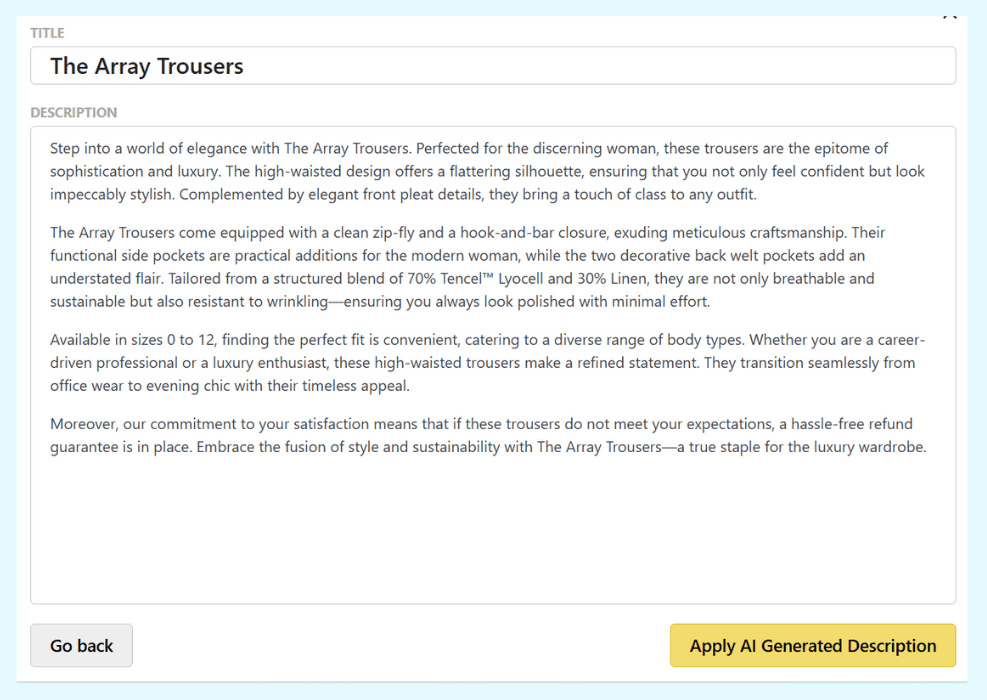
Its Product Summaries AI also creates compelling short descriptions, which are perfect for giving shoppers quick, scannable summaries. This ensures your product pages are optimized for both search engines and conversions.
Beyond individual products, its expertise in product category marketing is a key differentiator. It functions as a dedicated Category Description AI to optimize these crucial landing pages for both search engines and shoppers.
The suite also includes other valuable tools. The Product Tags Generator AI helps improve product discovery, while the Review Summaries AI builds trust by highlighting the best parts of your customer feedback.

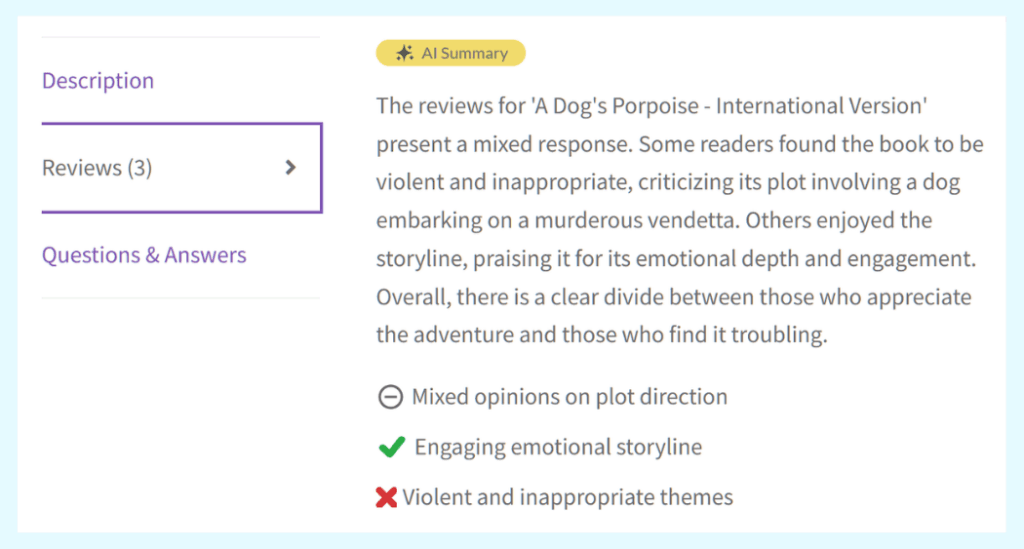
2. Generate content at ecommerce scale
Here is where general tools simply can’t compete. The true power I found in StoreAgent Content is its ability to handle content in bulk.
Instead of working on one product at a time, you can select dozens or even hundreds of products at once.
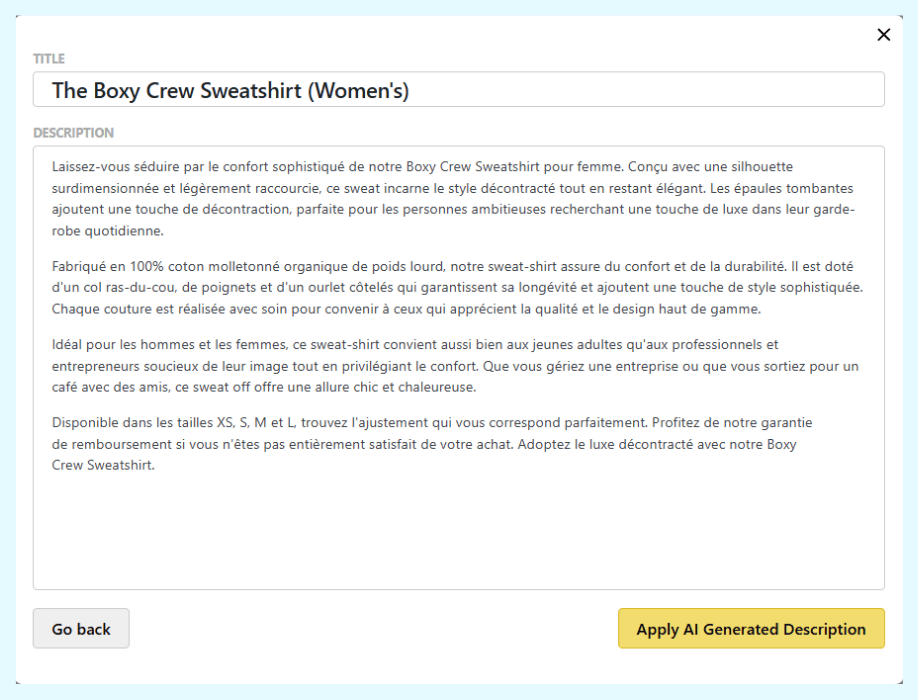
You can then generate first drafts for all of them in a single workflow. This completely changes the game for launching new collections, overhauling an existing catalog, or rolling out multilingual content across your entire store.
3. Go beyond generation with Content Insights
StoreAgent also includes a feature that no general tool offers: a proactive “Insights” dashboard.
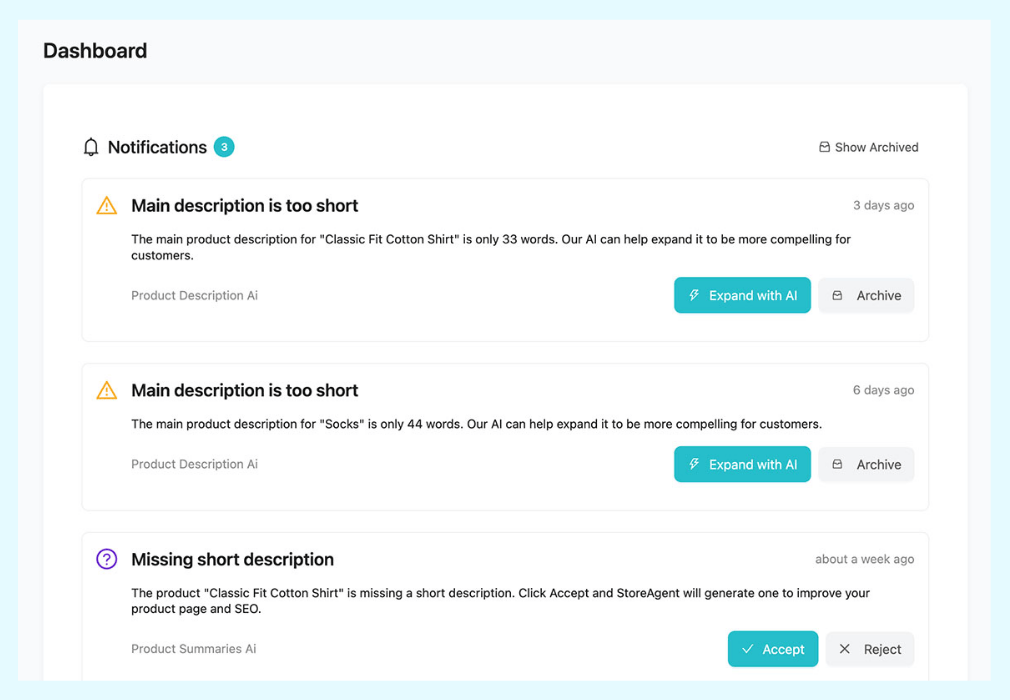
This truly makes it feel like an AI sidekick for your store.
The dashboard monitors your products and alerts you to content opportunities. For instance, it might find products with weak descriptions or missing information, then prompt you to use its AI content tools to fix them.
This shifts you from being reactive to proactively optimizing your store.
Who is StoreAgent Content for?
StoreAgent Content is for the WooCommerce store owner who is ready to stop the manual grind of copy-pasting from generic tools. It’s for the founder who wants to automate tedious content tasks, expand into global markets with a powerful multilingual AI, and focus on growing their business.
Conclusion
Choosing the right AI content tools in 2025 comes down to understanding your primary workflow. While general tools are great for tasks like blogging, they just aren’t built for the heavy lifting an online store needs.
The bottom line is simple: using the right tool for the job gets you better results and saves a lot of time.
We hope this guide helped clear things up! We walked through all the key points to help you decide, including:
- Finding the right AI content tool
- Best tools for general and long-form content
- Top platforms for social media and short-form copy
- StoreAgent Content as an AI tool for ecommerce
If you spend your days managing a WooCommerce store, a tool made just for ecommerce is your best bet. It’s the simplest way to get high-quality, SEO-friendly content for all of your products.
If you’re ready to spend less time on tedious tasks and more time growing your business, we’re here to help. Explore our plans and find the right one for your store.
Frequently Asked Questions
Here are some frequently asked questions about AI content tools. I hope these asked questions provide more clarity!
Will AI-generated content sound generic or like a robot?
This is a common concern, but modern AI is much more advanced. The best tools are now designed to create very natural-sounding copy.
A specialist tool like StoreAgent can even learn from your brand voice. It uses your existing product data to write in a style that feels authentic to your store.
Is AI-generated content unique? Will I get penalized for duplicate content?
Search engines don’t penalize AI by itself. Problems come from thin or unhelpful content. Ground your copy in unique product details and reviews, then human-edit. Use category pages to add context beyond specs.
Are AI content tools worth the monthly cost for a small store?
First, consider how many hours you spend on content writing each month. Estimate time per SKU and per category page.
If a tool can reduce that time by 80-90%, it often pays for itself very quickly. This allows you to focus on other parts of your business, like marketing and customer service.
How do I choose between the top-rated AI content tools for online stores?
If your priority is blog content, choose a writer + SEO optimizer. If your priority is SKUs, pick a tool with WooCommerce sync, bulk generation, category support, and a path to ongoing upkeep (e.g., StoreAgent’s Insights).
Identify your most time-consuming writing task. If it’s blogging, choose a general writing assistant. For a deeper dive into other options, read our guide on online store AI tools and WordPress.
Does using AI mean I don’t need a human writer anymore?
Not at all. It’s best to think of AI as a powerful assistant, not a replacement for a person.
AI generates the first draft in seconds, handling the most tedious work. A human then acts as a strategic editor, adding the final polish and creative touches. This combination is much faster and more efficient than starting from a blank page.
